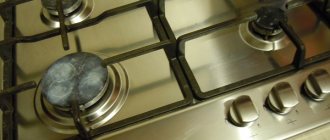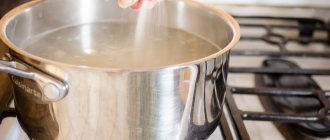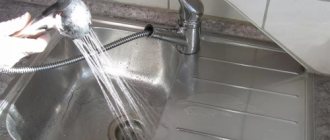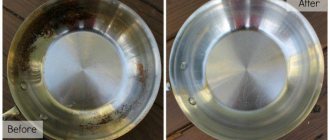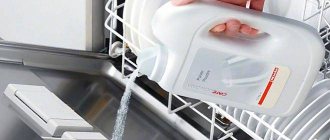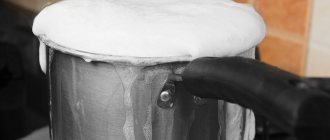Home page » Home and comfort » Cleaning
Author of the article
Svetlana Pavlikhina
Reading time: 5 minutes
AA
Metal utensils are difficult to clean. It is difficult to remove fat or carbon deposits. You can clean a stainless steel kettle using traditional methods.
Outside, it is better not to use a hard wire brush or powders with abrasive particles to maintain the gloss and smoothness of the surface.
Features of the cleaning process
Stainless steel is a heat and grease resistant material. Over time, the surface becomes covered with contaminants, which not only spoil the appearance of the dishes, but also destroy the structure of the metal. You should get rid of plaque immediately when it appears.
Recommendations for cleaning stainless steel:
the surface of the dishes is washed with a soapy sponge after each boiling, especially for an electric kettle;- preference is given to manual cleaning rather than machine cleaning;
- after washing, thoroughly wipe the outside of the kettle with a towel so that no drops of water remain;
- do not use steel wool or rough products with large abrasive particles;
- A stainless steel kettle should not be cleaned using circular movements.
After washing, to add shine, rub the metal surface with a slice of raw potato.
Kettle cleaning equipment
In order to clean the kettle, first of all, you need to prepare all the materials so that you don’t have to run around the kitchen with wet hands looking for the right rag or something else. Here is the basic list of required items:
- Rag or sponge – It is best to choose a double-sided sponge, one side of which is stiffer. But you also need to prepare a rag from viscose or microfiber, or take a regular piece of cotton fabric.
- Rubber gloves - it is best to protect your hands and work in special gloves. Cleaning will not take two minutes, and therefore the products used may not have a very beneficial effect on the skin of your hands (even if it is ordinary soda).
- Container with water - it is best to wash the kettle in a bowl or small basin. If it is enameled, then it is better to choose a plastic bowl so as not to knock off the enamel.
- Cleaning agent - you don’t need to collect all possible products and attack the dirty kettle with all of them at once; it’s better to choose one of the options.
The cleaning method depends on the material the kettle is made of. The most common utensils in the kitchen are stainless steel (stainless steel) and enameled.
We must immediately warn all lovers of harsh measures. Don't be so quick to grab the metal jaws and try to get rid of the grease on the outside by simply scraping it off. If you overdo it, such sponges will leave scratches that will become even more clogged with grease and dirt. It will be more difficult to clean such a kettle each time, and its appearance will deteriorate.
If it is enameled, then cleaning it with a metal sponge is generally contraindicated.
Types of contaminants and their removal
To clean a stainless steel kettle at home, choose products depending on the type of dirt.
Fat
Baking soda will help get rid of sticky grease splatters. This is an affordable and safe remedy.
First, wash the kettle in hot water with dishwashing liquid and wipe dry. Contaminated areas are generously sprinkled with soda. You can dilute it with a little water to make a paste.
The substance is left on the surface of the stainless steel for an hour. Afterwards, wipe the kettle until it shines with a dry cloth.
Nagar
A regular detergent will help to clean the kettle from carbon deposits. It is dissolved in a large saucepan filled with water. Dip the kettle into the soapy liquid and place the container on the stove.
The soap solution is boiled for 10–15 minutes, after which the kettle is removed. Softened plaque can be easily removed with a kitchen sponge and soda.
You can also soften carbon deposits in a soda solution (3 tablespoons of product per 1 liter of water). The kettle is lowered into the liquid and boiled.
Stove cleaner works well to remove carbon deposits. First, the kettle is heated in hot water (it is lowered into a larger pan filled with liquid). Then apply the slab cleaner and leave for 20 minutes. Clean with dishwashing detergent under running water and wipe dry.
How to add shine
Ways to add shine to a metal surface:
- A stainless steel kettle is rubbed with a cloth soaked in lemon juice or vinegar. After the procedure, dry the glossy surface with a clean towel.
Raw potatoes will help clean stainless steel from stains that remain on the metal after contact with water. Rub the surface with a slice of vegetable, then polish with a soft, dry towel.- The washed kettle is wiped dry. Then a drop of mineral body oil is applied to a kitchen sponge and buffed.
- Ammonia will help to wash stainless steel until it shines. 10 drops of this alcohol are dissolved in 1 liter of water and mixed. The washed and dried teapot is rubbed with this solution until it shines.
- Potato decoction is not poured into the sink, but is used to add shine to stainless dishes. A clean soft cloth is soaked in potato water, which contains starch, and the kettle is treated. Then rub the surface with a clean, dry cloth.
How to clean a glass teapot
- Now about how to clean a glass teapot. Of course, the safest remedy is organic acids. Or rather, natural products with a high content of these acids. These are apple cider vinegar, citric and succinic acids. The use cases are described above. The only thing I can add is to use only one product at a time. Mixing can give the most unpredictable results.
- The chemical industry also offers a wide range of mixtures containing organic acids. For example, German Glutoclean contains up to 15% of such acids and is completely safe for kitchen appliances. The main condition for all industrial anti-scale agents is strict adherence to the manufacturer’s instructions.
- But it is not recommended to clean a glass teapot from carbon deposits or scale with Coca-Cola. Firstly, because the heating elements can be damaged. Secondly, there is a high probability of dark spots appearing on the glass. Instead, it’s better to boil half a lemon several times – not a trace of scale will remain!
Folk remedies
You can wash off carbon deposits and grease using folk recipes.
Soda + vinegar
Soda powder (2–3 tbsp.) is diluted with 1 tsp. vinegar until foamy. It is applied liberally to the metal surface and allowed to act for a quarter of an hour. The stains are then removed with a kitchen sponge soaked in detergent.
Lemon acid
Acid and lemon juice remove whitish deposits from the metal surface.
Soft woolen fabric is soaked in juice or an aqueous solution of citric acid (1 teaspoon of granules per glass of water). The outer surface of the dishes is thoroughly rubbed with this product and washed off under running water.
Toothpaste
The paste is applied to the surface of the stainless steel using rubbing movements and left for half an hour. Then remove the dried crust with a sponge soaked in soap suds and wash under running water.
Persistent stains from burning are removed with a mixture of toothpaste and a few drops of ammonia applied to the hard surface of a kitchen sponge, and the metal is rubbed until it shines. Afterwards the kettle is washed with water and dish soap.
Potato peel
Potato peelings are filled with water so that the liquid barely covers them. This mixture is boiled for 15–20 minutes. Rub the resulting solution onto the stainless steel, removing dull whitish spots from it.
Mustard powder
Chopped mustard (2 tbsp) is poured into 0.5 liters of hot water and mixed. The solution is used to treat the contaminated surface.
Particularly stubborn stains can be removed with a toothbrush.
After the procedure, the dishes are rinsed with running water.
Activated carbon
Black tablets are crushed in a mortar. You should get a fine powder, like powder. It is diluted with water to obtain a thick paste and applied to the entire outer surface of the teapot, left for 20 minutes. Later, the black layer is removed with the hard surface of a sponge, and the kettle is washed under the tap.
Coffee grounds
The remaining Turkish coffee is mixed with lemon juice until a thick paste is formed. The outer part of the kettle is treated with this mixture until it shines. Then the product is washed off with clean water and the surface is wiped dry.
What else can you do to remove grease from a kettle?
People have other ways to get rid of dirt on the surface of kitchen utensils. Some of them look quite exotic. You can clean a nickel-plated kettle using these methods.
Cucumber pickle
This winter preparation product is suitable not only for food. You will need a lot of brine. Place a kettle or any other kitchen utensil that needs cleaning in a suitable container. Everything is poured with pickled cucumber brine, brought to a boil and left to simmer for half an hour.
Important! After such a procedure, salt streaks may remain, which can be easily removed with a sponge and running water.
PVA glue and laundry soap
This combination can be used to clean surfaces from greasy stains. First, prepare a mass of soap and glue. Calculations are made for four liters of water. Pass half a standard piece of laundry soap through a coarse grater, add four tablespoons of glue. Mix everything and add water. Boil a kettle in the resulting solution for half an hour. After the procedure, the dishes are washed with warm water and wiped dry.
Household chemicals
Such products will help clean stainless steel products quickly and effectively.
Laundry soap
Fill a large saucepan with water, rub in half a bar of laundry soap, and mix. Place a kettle in the container, heat the liquid to a boil and keep on fire for 15–20 minutes. After the water is cooled, the dishes are washed in the usual way.
Boiling softens even the most stubborn stains.
Dish detergent
Suitable for daily cleaning of the kettle. It is recommended to wash it after each use to avoid the formation of persistent stains.
Special products for stainless steel
The modern market for household chemicals offers a large selection of powders, gels, liquids, and foams for cleaning metal surfaces. They act comprehensively, removing not only stains, but also adding gloss and shine .
The most effective of them:
- Cif cream for stainless steel surfaces;
- "Shumanite";
- Cillit.
To perfectly clean stainless steel, you need to study the instructions for each product.
Procedure:
- Hands are protected with rubber gloves.
- The required amount of product is applied to the metal surface.
- Maintain a certain time (it is indicated in the instructions for use).
- The substance is removed with a sponge.
The kettle is rinsed with warm water and wiped dry.
Preparation for the procedure
Before proceeding directly to the procedure, it is necessary to take substances and prepare equipment in advance. To carry out the procedure you need:
- sponge or rag;
- latex gloves;
- a container of water into which the contaminated kettle will be completely placed.
When you need to decide exactly what to clean with, immediately take the necessary cleaning products.
Another important step in preparing the kettle for the cleaning procedure is soaking it. However, you need to be careful not to expose the dishes to temperature changes. The already cooled kettle needs to be soaked in water.
Mechanical methods
You can influence stubborn dirt not only with chemicals, but also with friction. This is an equally effective method.
Melamine sponge
The porous soft material thoroughly and carefully cleans all types of surfaces. The sponge is moistened with water, squeezed out, pressing it against a horizontal surface (the material cannot be twisted). The sponge is ready for use; no detergent is required.
Rub the stain with a sponge until it completely disappears; after the procedure, there are no streaks or scratches left on the surface.
Dishwasher
The stainless steel kettle is washed together with other kitchen utensils. It is often not recommended to carry out such a procedure for stainless steel, but this technique is also used as necessary.
Prevention measures
To avoid problems with how to clean the kettle from certain contaminants, you need to handle it correctly. There are a number of measures to prevent the appearance of dirt, grease and plaque. These include:
- keeping dishes clean and cleaning them as needed;
- using only clean filtered water;
- pour out the remaining liquid after boiling;
- putting dishes away for storage if they are not currently in use, especially if something else is being cooked on the stove at that time;
- Do not place an empty vessel on an open fire, and especially do not forget it for a long time.
To prevent the appearance of dirt inside the kettle, boil it with a light soda solution.
Care instructions
Before using a stainless steel kettle for the first time, remove all stickers, wash the vessel in warm soapy water, rinse under the tap and wipe with a soft absorbent cloth.
An empty kettle should not be placed on the burner. If this happens, it is allowed to cool on its own.
The burner flame should not go beyond the bottom.
The vessel is washed or wiped after each use, having cooled it first.
Cleaning an electric kettle
The electric kettle should only be washed after being unplugged. In many models, you can pull out the cord that is attached to the base.
After washing, the kettle must be dried and only then connected to the cable.
Aggressive methods using baking soda or citric acid are not suitable for removing stains from plastic surfaces. But if you have any carbonated drink in the refrigerator, you don’t have to run to the store for a cleaning product. It is better if it is a colorless liquid, since Coca-Cola or Pepsi can color the light surface of the dishes.
Use soda to treat greasy stains and leave for 30-60 minutes. Then rinse everything off with water, scrubbing away any dirt with a sponge. This drink can also be used to remove scale by pouring soda into a kettle and boiling it. The cleansing effect is achieved by the presence of acids in the composition of such water.
You can also wipe an electric kettle with lemon. It will lighten yellow spots and help remove oil.
You can use products in the form of powder, tablets or granules (for example, Antiscale from the Sanita brand). They cope with heavier deposits on surfaces.
Other Tips for Effective Cleaning
Many housewives use apple peelings by adding them to boiling water. But this method will remove only weak stains, and old oil residues will remain in place.
If milk has turned sour in the house, do not throw it away, because it is an excellent means of removing fat. It is suitable for an electric kettle or stainless steel. Rub the surface with sour milk and leave for half an hour.
Preventative cleaning of the kettle once a month will help get rid of greasy stains, which are then difficult to remove. But even if they appeared, now you know what to do.
Cannot be restored
Let's start with the fact that in some cases even the most effective cleansing methods will not help. If the kettle “puffs” on the stove empty for a long time (the water has boiled away completely), then serious damage to the bottom and walls of the cookware cannot be avoided.
Dark carbon deposits appear inside and outside, and rainbow stains and stains are visible on the stainless steel walls. Iron cookware with an enamel coating shows cracks and the top layer is deformed. And while products made from durable alloys can still be tried to be revived (cleaned and washed), then models with enamel cannot be restored.
Sodium carbonate
Using soda ash at home will get rid of even the most stubborn stains not only from dishes, but also from the stove. At the same time, unlike household chemicals, they are safe for health and much cheaper. If you don't have technical soda, you can replace it with regular baking soda, the cleaning properties of which are beyond doubt.
The kettle is preheated over a fire, after which it is placed in the sink, sprinkled with soda and cleaning begins. It’s worth noting right away that it will take a long time to rub in. However, the time and effort spent will be completely worth it. Dishes will return to their original glory, as if they were freshly purchased from the store. When all contaminants have been removed, it is washed with warm water.
How to bring burnt metal utensils back to life
So, we have discussed in detail how to clean the outside of a stainless steel kettle. You could see for yourself that there is nothing complicated here. But if you forgot metal utensils on the fire, as a result of which they burned, it will not be so easy to restore its aesthetic appearance. According to experts and housewives, to remove carbon deposits you can use:
- specialized cleaning products.
- detergent;
- washing powder;
- coarse table salt;
However, you need to use one or the other. By combining various elements, you can achieve the completely opposite effect, in which it will no longer be possible to preserve the dishes. The easiest and fastest way to get rid of carbon deposits is to immerse the kettle in water with diluted detergent or any dishwashing detergent. It is very difficult to say how long you will have to wait. It all depends on the degree of pollution. As soon as the dirt softens a little, the metal is washed with damp salt and rinsed under running water.
It is worth noting that the principle of using all products is the same, therefore, regardless of what exactly is used to clean stainless steel, all work should be carried out according to the same scheme. The main thing is to use only one, as overlapping can lead to unwanted chemical reactions.
Cleaning the kettle from carbon deposits
This has happened to many: I was too lazy and the kettle got burnt. The first desire is to throw it away and not suffer. Then reason begins to speak, calling for savings: the kettle can still serve. And this is the right decision: there is a simple way to wash it from grease and carbon deposits.
Pour water into a large saucepan, dissolve in it a mixture of 100 g of soda and 100 g of laundry soap shavings or 80 g of silicate glue, immerse a kettle in the solution, and boil. After the water has cooled, remove the kettle from it and wash it with a sponge.
Aluminum cookware can be cleaned from carbon deposits using activated carbon. To do this, you need to take several tablets, crush them, rub them on the surface, let them stand for 10 minutes and rinse.
Fat deposits can often be washed off using a mixture of vinegar (2 parts) with salt and soda (1 part each). It needs to be applied to a sponge, rub the surface, and rinse off.
It is not difficult to clean a kettle made of any material, including an electric kettle, from rust and scale, especially if you do not bring it to a deplorable state. If you wash it after each use, there will simply be no scale.
